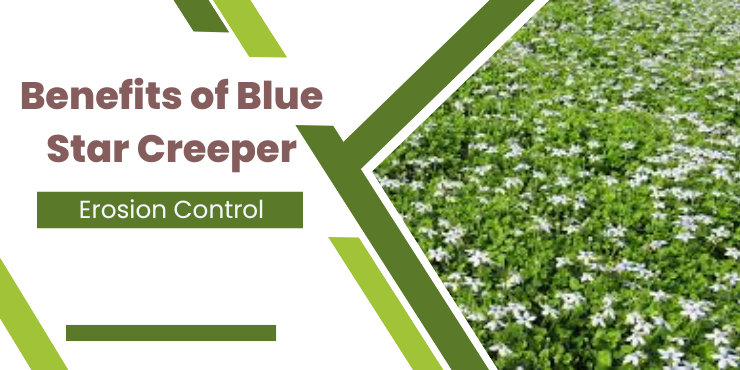Ground cover blue star creeper, scientifically known as Isotoma fluviatilis, is a versatile and charming plant that is covered by gardeners and landscapers alike. With its small, delicate foliage and sweet, star-shaped blue flowers, this low-growing perennial adds a touch of enchantment and beauty to any outdoor space. Whether used to fill in gaps between stones or as a lush carpet in a shady garden, blue star creeper is a reliable and low-maintenance ground cover that thrives in a variety of conditions. Join us as we explore the many benefits and uses of this delightful plant, and learn how it can transform your landscape into a vibrant and inviting oasis.
Ground cover blue star creeper
Ground cover blue star creeper, also known as Isotoma fluviatilis, is a low-growing perennial plant that forms a dense carpet of delicate blue flowers and small green leaves. It belongs to the campanula family and is native to Australia and New Zealand. This hardy and versatile plant is commonly used as a ground cover in gardens, lawns, and between paving stones. Blue star creeper is tolerant of various soil types and can grow in both full sun and partial shade, making it a great option for filling in spaces where grass or other plants struggle to thrive. It has a spreading growth habit and can quickly fill in an area, helping to suppress weeds and erosion.
The vibrant blue star-shaped flowers bloom from spring to summer, adding a pop of color to any landscape. Additionally, blue star creeper is relatively low maintenance and requires little to no pruning or fertilization. Overall, its attractive appearance, adaptability, and ease of growth make ground cover blue star creeper a popular choice for both novice and experienced gardeners.
The Allure of Blue Star Creeper
A Carpet of Blue Delight
A Carpet of Blue Delight describes the aesthetic and practical qualities of the blue star creeper plant, also known as Isotoma fluviatilis. The description highlights its versatility, charm, and popularity among gardeners and landscapers. It further elaborates on the plant’s small foliage, star-shaped blue flowers, and its ability to enhance any outdoor space. Additionally, the description mentions the various ways in which blue star creeper can be used, such as filling gaps between stones or creating a lush carpet in shade. The description also emphasizes the plant’s low-maintenance nature and its ability to thrive in different conditions. Overall, “A Carpet of Blue Delight” entices readers with the allure and potential of this enchanting ground cover plant.
Versatility in Design
“Versatility in Design: Blue Star Creeper” showcases the adaptability and visual appeal of the blue star creeper (Isotoma fluviatilis) ground cover plant. The description highlights the plant’s ability to fit seamlessly into a range of garden designs, making it a sought-after choice for both professional landscapers and gardening enthusiasts. The blue star creeper’s petite foliage and charming blue star-shaped flowers contribute to its overall appeal, creating a delicate and enchanting aesthetic. Additionally, the description emphasizes the plant’s practical uses, such as filling gaps between stones or serving as a lush carpet in shady areas. Furthermore, blue star creeper is praised for its low-maintenance requirements and ability to thrive in diverse environmental conditions. Overall, “Versatility in Design: Blue Star Creeper” celebrates the beauty and versatility of this ground cover plant, and encourages readers to consider incorporating it into their own garden designs for an exquisite and seamless look.
Cultivation and Care
Location Matters

“Blue Star Creeper: The Perfect Groundcover” highlights the qualities and benefits of the blue star creeper (Isotoma fluviatilis) as a ground cover plant.
The description emphasizes its effectiveness in filling up empty spaces and creating a verdant carpet-like appearance in outdoor areas.
The blue star creeper’s petite foliage and vibrant blue flowers add a touch of elegance and beauty to any location. The plant’s adaptability to a variety of conditions and its resilience make it an ideal choice for gardens, pathways, and landscape designs.
Moreover, its low-maintenance nature ensures that it requires minimal effort to grow and maintain. “Blue Star Creeper: The Perfect Groundcover” showcases the blue star creeper as a versatile, resilient, and visually striking plant that can enhance the aesthetic appeal of any location.
Soil and Watering
Blue star creeper thrives in moist, well-draining soil. The ideal soil for this plant is rich in organic matter and has a slightly acidic to neutral pH. It is important to ensure that the soil does not become waterlogged, as excessive moisture can lead to root rot and other issues. When watering blue star creepers, it is best to keep the soil consistently moist but not soggy.
This plant does not tolerate drought well and can quickly suffer if it dries out. However, overwatering should be avoided as it can lead to root issues and fungal diseases. During the hot summer months, it may be necessary to water blue star creepers more frequently, especially if they are grown in full sun. Mulching around the plant can help to conserve moisture and regulate soil temperature, which can be beneficial in maintaining optimal growing conditions. Regularly monitoring the moisture level of the soil is key to determining the.
Pruning for Lushness
Pruning is an important practice in maintaining the lushness of blue star creepers. This plant tends to spread and can become invasive if not properly managed. Regular pruning helps to control its growth and maintain a neat and compact appearance. Pruning blue star creepers can be done throughout the growing season. It is best to remove any dead, damaged, or diseased foliage as soon as they are noticed. This not only improves the plant’s appearance but also prevents disease from spreading. To encourage lushness and prevent the plant from becoming leggy, it is recommended to give blue star creepers a light shear after flowering. This helps to stimulate new growth and keeps the plant more compact and full. Another way to promote lushness in blue star creepers is by dividing and replanting the clumps every few years. This helps to rejuvenate the plant and prevent it from becoming overcrowded. Dividing can be done in early spring or fall. Overall, with proper care and maintenance, blue star creepers can create a lush and vibrant environment.
Benefits of Blue Star Creeper
Erosion Control

The dense mat of blue star creeper helps to stabilize soil and prevent erosion by reducing the impact of rainwater and runoff. Its root system holds soil in place, making it less susceptible to washouts and soil displacement. In addition to erosion control, blue star creeper offers several other benefits. It acts as a natural weed suppressor, crowding out unwanted plants and reducing the need for herbicides. Its dense growth also helps to inhibit the growth of weeds by shading the soil and preventing weed seeds from germinating. Blue star creeper is a pollinator-friendly plant, attracting bees and butterflies with its nectar-rich flowers. This can contribute to a healthy and diverse ecosystem in your garden or landscape. Furthermore, the lush green foliage of blue star creeper adds visual interest and enhances the aesthetic appeal of any outdoor space. It can be used as a filler plant in gaps between larger shrubs or as groundcover in garden beds, pathways, and rock gardens. Overall, the benefits of blue star creeper for erosion control make it an attractive and practical choice for those seeking to prevent soil erosion, maintain a tidy landscape
Weed Suppression
Weed Suppression blue star creeper is perfect for areas with poor soil quality or in places where it is difficult to grow other plants. It is also suitable for planting in between pavers or stepping stones, as it can tolerate light foot traffic. The plant is known to attract bees and other pollinators, adding a lively touch to any garden.
This versatile groundcover requires minimal maintenance, though regular watering is necessary, especially during hot and dry weather. It thrives in full sun to partial shade and can tolerate a wide range of soil types, including clay, loam, and sandy soil
Biodiversity Booster
Overall, Biodiversity Booster blue star creeper is a beautiful, low-maintenance ground cover plant that not only adds aesthetic appeal to gardens but also provides practical benefits such as weed suppression and erosion control. Its ability to attract pollinators and support biodiversity makes it a valuable addition to any garden striving for a more sustainable and vibrant ecosystem.
Design Inspirations
Enchanting Pathways
Enchanting Pathways blue star creeper is a low-growing plant, reaching a maximum height of 2-4 inches (5-10 cm) and spreading up to 16 inches (40 cm). It is a hardy plant that is well-suited for a variety of growing conditions, including full sun to partial shade.
One of the unique features of Enchanting Pathways blue star creeper is its ability to self-seed, meaning it can quickly fill in gaps and expand its coverage over time. This makes it an excellent choice for filling in bare patches or areas where other plants struggle to grow.
Serene Water Features
The Serene Water Features blue star creeper is a beautiful and vibrant ground cover plant that adds a touch of serenity and elegance to any space. Known for its delicate blue flowers and closely-knit, carpet-like growth habit, this creeper creates a stunning visual display and is often used in water features, ponds, or as a trailing plant in rock gardens. With its low-growing nature, it forms a dense and lush carpet that adds a unique texture and color contrast to your landscape. The blue star creeper is also a great option for filling in gaps between pavers or stepping stones, creating a soft and inviting pathway. Easy to grow and maintain, this water-loving perennial thrives in moist, well-draining soil and can tolerate partial shade, making it a versatile and adaptable choice for various garden styles. Whether you’re looking to create a serene water feature or enhance the aesthetics of your landscape, the Serene Water Features blue star creeper is a beautiful and versatile choice that will bring tranquility and charm to your outdoor space.
Final Thought:
Ground cover blue star creeper is a versatile and attractive plant that can be a great addition to any garden or landscape. Its low-growing habit and dense, mat-like growth make it perfect for filling in spaces and suppressing weeds. Additionally, its vibrant blue flowers add a touch of color to any area. Blue star creeper is also easy to care for, tolerating a wide range of soil types and conditions. Overall, it is a fantastic choice for those looking to add beauty and functionality to their outdoor spaces.
FAQs
- Is Blue Star Creeper suitable for shaded areas?
Absolutely! Blue Star Creeper thrives in partial shade, making it an ideal choice for areas with limited sunlight.
- How often should I water Blue Star Creeper?
Watering should be regular but not excessive. Keep the soil evenly moist, especially during its establishment phase.
- Can I use Blue Star Creeper between pavers?
Yes, the low-growing nature of Blue Star Creeper makes it perfect for planting between pavers, adding a touch of beauty to your pathways.
- Does Blue Star Creeper attract any pests?
Generally, Blue Star Creeper is not prone to serious pest issues. However, keep an eye out for aphids or slugs and take appropriate measures if necessary.
- Is Blue Star Creeper suitable for container gardening?
Yes, Blue Star Creeper can thrive in containers, providing you ensure proper drainage and adequate care.
